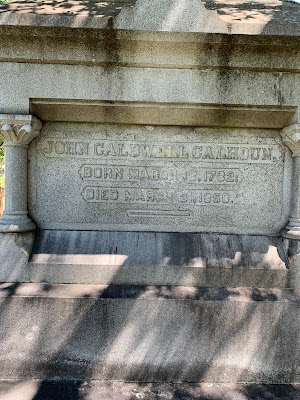The next day, Sunday, we decided to go back downtown but thought we'd stop on the way at The Citadel, which is a public senior military college. The college was established in 1842 and is one of six senior military colleges in the United States.
There are 2,300 Cadets and is one of the largest uniformed bodies in the U.S. There are approximately 1,350 non-cadet students enrolled in Citadel Graduate College pursuing undergraduate and graduate degrees.
We took a drive around the campus which was very quiet since it was Sunday morning.
Officer's Residence
The football stadium was in the middle of campus.
G3, is the current Citadel mascot. He was the third mascot to be named after General Mike D. Groshon.
And then, of course, we had to find the bookstore. It was Sunday morning so we figured it would be closed but were pleasantly surprised when we found it open.
Hats!
Ron's pick
We were parked by the parade grounds so I took a few photos.
Next on the agenda - downtown and the cemetery. Look at that - the gate was open and they were welcoming us!
We walked across the street to another part of the cemetery where John C. Calhoun was interred. John Calhoun served as the Vice President under John Quincy Adams and Andrew Jackson, as well as other political offices over the years.
It was my kind of place - historical and a bit quirky. We asked the server when the building was built and she said it was either 1816 or 1861, she couldn't remember which. So I looked it up and found it was actually built in c. 1806 by William Inglesby with the facade from c. 1870.
Lunch was good. I'm normally not too interested in seeing what others had to eat but I just can't help myself. Ha!
As we looked around the restaurant Ron spotted these right above us.
As we walked back to the truck we looked up and saw a building and wondered what it was so we walked the 2 blocks to check it out.
So we went in to look around. This is what the building looked like in 1820.
The Exchange was built to accommodate the expanding needs of the vast trading and shipping business that flourished in the City of Charles Town. The merchants and investors of the town's elite petitioned the South Carolina colony's Royal Assembly in 1767 to pass an act for the Exchange to be built. Among other notable events, South Carolina declared independence from Great Britain from the steps of the Exchange on March 28, 1776.
The Rebecca Motte Chapter of Daughters of the American Revolution (DAR) has made the Old Exchange Building its headquarters since 1921. They moved out during World War II, and resumed occupancy at the end of the war. They have a special chapter room where it holds its meetings, displays its antique and artifact collection to the public, and houses its archives with documents dating back to the chapter's founding in 1895. As a new DAR member, I was impressed - and here it is!
And then we went down to the dungeon for a tour. Over the years, as the building was under repair, they excavated the foundation and found this wall buried below the building. It was apparent that there was a few feet of water at the base of the wall and the guide explained that it floods when it rains, it floods at high tide, and it floods when it doesn't rain. In other words, it's always flooded.
This is what the Exchange and wall looked like back in the day.
The tour guide was an interesting guy and sure knew his stuff.
As we left we said goodbye to Christopher Gadsden, the creator of the "Don't Tread On Me" flag.
Phew, it was a long day!





































I love a college campus. The only thing better is a college town - always something fun to find there.
ReplyDeleteIt was pretty dead the day we were there.
Delete